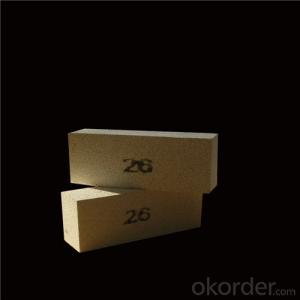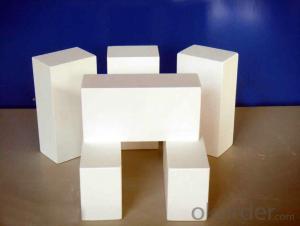Insulating Fire Brick - Lightweight Insulating Fire Brick
- Loading Port:
- Qingdao
- Payment Terms:
- TT OR LC
- Min Order Qty:
- 600 pc
- Supply Capability:
- 6000 pc/month
OKorder Service Pledge
OKorder Financial Service
You Might Also Like
Applications:
Kilns for the ceramic, tunnel, shuttle
Forge furnaces
Carbon baking furnaces
Atmosphere furnaces
High temperature kiln lining
Back up insulating of glass melting tanks
Insulating of tin bath area for float glass
Blast furnaces
Chemical and petrochemical industry
Non-ferrous metal industry
Product Description:
As specified by name, Insulating firebricks are of light weight, low thermal conductivity, excellent strength at ambient and elevated temperature. With very low levels of iron and other impurities, the bricks provide good resistance to chemical attach, can be used in tough, reducing atmosphere conditions. Every brick is ground to precise dimensions.
CNBM (China National Building Material) Group is the largest comprehensive building materials group in China that integrates scientific research, manufacturing and logistics into one entity. CNBM is also the largest building materials and equipment specialists in China. Upon the State Council’s approval, CNBM owns more than 300 subordinate manufacturing factories and servicing companies till now. There are 6 fully owned public listed companies and 11 partially owned with substantial shares public listed companies. In many such of these fields, CNBM is playing a
leading role in the building industry in the country. CNBM International Corporation is the most important import
and export platform of CNBM group. With its advantages, CNBM International are mainly concentrate on Cement industries and devotes herself for supplying high quality series of refractories as well as technical consultancies and logistics solution.
CNBM International is highly recognized by its business partners and clients all over the world and has obtained rapid development under the spirit of win-win. Depending on the support of production divisions and its active staff, CNBM international reached a turnover of USD one billion in 2012. We will carry on the mutual beneficial, create value for our employees, share holders and clients and benefit the whole society in our future development.
Thanks you for your interest in our company products and
services. Your valuable comments are most welcome.


- Q: What are the different types of insulating fire bricks available in the market?
- There are several types of insulating fire bricks available in the market, including lightweight insulating bricks, super lightweight insulating bricks, high alumina insulating bricks, and mullite insulating bricks. Each type has unique properties and is suitable for different applications.
- Q: Are insulating fire bricks resistant to water penetration?
- Insulating fire bricks exhibit resistance to water penetration. These bricks possess a low porosity and are fabricated from materials that do not readily absorb or retain water. Typically, they consist of lightweight refractory materials like alumina, silica, and other minerals that possess remarkable heat resistance and minimal water absorption capabilities. Consequently, insulating fire bricks are highly suitable for scenarios where water penetration could be detrimental, such as in high-temperature environments or when utilized as insulation in chimneys or kilns. However, it is essential to acknowledge that while these bricks resist water penetration, they are not entirely impervious to it. Prolonged exposure to water may eventually result in some degree of water absorption, which can impact their insulating properties. Therefore, it is prudent to exercise caution and ensure proper installation and maintenance to optimize their resistance against water penetration.
- Q: How do insulating fire bricks compare to other types of refractory materials?
- Insulating fire bricks have a higher insulating capability compared to other types of refractory materials. They are lighter in weight, have lower thermal conductivity, and provide better energy efficiency. However, they may have slightly lower strength and durability compared to dense fire bricks or other refractory materials.
- Q: Are insulating fire bricks resistant to pests or rodents?
- Insulating fire bricks are not specifically designed or treated to be resistant to pests or rodents. While the dense nature of these bricks may make it more difficult for pests or rodents to chew through them compared to other materials, they are not completely immune to infestations. If you are concerned about pests or rodents, it is advisable to take additional measures such as sealing any gaps or cracks in the brickwork, ensuring proper ventilation, and implementing pest control methods as needed.
- Q: Can insulating fire bricks be used for insulation in heat exchangers?
- Insulation in heat exchangers can be achieved by utilizing insulating fire bricks. These bricks are constructed from a lightweight refractory material that boasts exceptional thermal insulation properties. With their low thermal conductivity, insulating fire bricks effectively minimize heat transfer between the two sides of the heat exchanger. Consequently, they aid in maintaining the desired temperature within the heat exchanger and prevent heat loss to the surroundings. Furthermore, the durability of these bricks is evident as they can endure high temperatures and thermal shocks, making them ideal for the harsh conditions typically encountered in heat exchangers. In summary, incorporating insulating fire bricks into heat exchangers not only enhances energy efficiency and reduces heat loss but also improves the overall system performance.
- Q: Are insulating fire bricks chemically resistant?
- Insulating fire bricks exhibit a wide resistance to numerous substances chemically. These bricks are typically composed of top-notch refractory materials, including alumina, silica, or a combination of the two. These materials possess exceptional chemical resistance, thereby endowing insulating fire bricks with formidable protection against the corrosive effects of diverse chemicals. Nevertheless, it is essential to acknowledge that the chemical resistance of insulating fire bricks may vary depending on their distinct composition and manufacturing techniques. While they generally withstand most chemicals, there exists a possibility of certain aggressive chemicals or extreme circumstances potentially causing the degradation or erosion of the bricks over time. To guarantee the utmost chemical resistance of insulating fire bricks, it is advised to consult the manufacturer's specifications or seek expert counsel pertaining to specific applications. Such measures will ensure that the bricks are suitable for the intended chemical environment and will consistently perform as desired throughout their expected lifespan.
- Q: There are several construction techniques for exterior wall insulation
- Exterior wall sandwich insulation technologyThe exterior wall sandwich insulation is to place the heat preservation material between the inner and outer wall sheets of the outer wall, and the inner and outer walls can be made of concrete hollow blocks.Advantage:1) to the inner wall piece and the heat preservation material forms the effective protection, to the heat preservation material selection material request is not high (source: Chinese heat preservation net), polystyrene, glass cotton and urea aldehyde field casting material and so on may use;2) the construction season and construction conditions are not very high, and it does not affect the winter construction. In Heilongjiang, Inner Mongolia, northern Gansu and other cold areas have been given some applications.Shortcoming:1) in non cold areas, this kind of wall is thicker than traditional wall;2) the inner and the outer wall pieces need to be connected by connecting pieces, and the structure is more complicated than the traditional wall;3) periphery structure of "bridge" more. In the earthquake zone, building circle beam and constructional column settings, "bridge" more efficiency of thermal insulation materials is still not fully play.4) outside the walls by the outdoor climate, the temperature difference between day and night and the large temperature difference between summer and winter, easy to cause the wall cracking and leakage of rainwater.
- Q: If there is a main component of cenosphere light insulating brick.
- Light heat insulation brick with cenosphere composition, material properties will be more high, especially the main properties of thermal conductivity
- Q: Is it possible to cut insulating fire bricks to fit custom shapes?
- Cutting insulating fire bricks to fit custom shapes is indeed possible. These bricks, composed of lightweight materials like ceramic fiber, can be easily cut or shaped using a range of tools. Cutting methods typically involve a saw, knife, or even a hot wire cutter. However, it is crucial to prioritize safety precautions and wear protective gear while undertaking this task. Dust and sharp edges may be produced during the cutting process. By employing suitable tools and techniques, it becomes achievable to tailor insulating fire bricks to any desired custom shape.
- Q: Do insulating fire bricks require any special installation techniques?
- Special installation techniques are necessary for insulating fire bricks. These bricks are designed to offer excellent thermal insulation, so proper installation is essential for optimal performance. To begin, it is crucial to have a clean and debris-free installation surface. This creates a strong and stable foundation for the bricks. Afterward, it is important to use a suitable refractory mortar or adhesive to secure the bricks in place. This mortar should be specifically designed for high-temperature applications and capable of withstanding thermal expansion and contraction during heating and cooling cycles. During installation, attention should be given to filling the joints between the bricks with mortar. This prevents heat loss and maintains the insulating properties of the bricks. Furthermore, careful stacking and alignment of the insulating fire bricks is necessary to ensure a tight fit and minimize gaps. This maximizes insulation and prevents heat leakage. Lastly, it is advisable to consult the manufacturer's guidelines and follow their recommended installation techniques. Different types of insulating fire bricks may have specific requirements that must be adhered to for proper installation. In summary, insulating fire bricks demand special installation techniques to ensure their effectiveness and longevity. Following proper installation practices will enhance the thermal insulation properties of these bricks and optimize their performance.
Send your message to us
Insulating Fire Brick - Lightweight Insulating Fire Brick
- Loading Port:
- Qingdao
- Payment Terms:
- TT OR LC
- Min Order Qty:
- 600 pc
- Supply Capability:
- 6000 pc/month
OKorder Service Pledge
OKorder Financial Service
Similar products
Hot products
Hot Searches
Related keywords




























